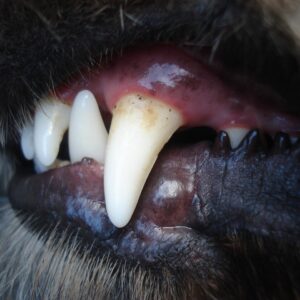Trocoxil for dogs

Formulation
Tablets
Active ingredient
Mavacoxib
Category
Pain relief / anti-inflammatory
What is Trocoxil?
Trocoxil is the trade name of the drug Mavacoxib. It is available as a tablet and is a non-steroidal anti-inflammatory drug used to manage pain and treat inflammation caused by degenerative joint disease (osteoarthritis) in dogs.
What does Trocoxil do?
- Long-Acting Formulation: Trocoxil is unique for its extended-release formulation, providing sustained pain relief for an extended period (typically a month) after a single dose.
- Absorption: Mavacoxib is absorbed from the gastrointestinal tract after oral administration, gradually releasing into the bloodstream.
- Distribution: Once absorbed, Trocoxil is distributed throughout the body, reaching areas where inflammation occurs, such as joints.
What is Trocoxil for?
- Osteoarthritis Relief: Trocoxil is primarily prescribed to dogs with osteoarthritis to improve mobility and reduce pain and inflammation in the joints.
- Long-Lasting Pain Management: Due to its extended-release formulation, Trocoxil provides long-lasting pain relief, reducing the frequency of dosing.
Always follow the veterinarian’s recommendations for the correct dosage based on your dog’s specific needs. Regular veterinary check-ups are important to monitor your dog’s response to Trocoxil and make any necessary adjustments. If you notice any unusual or persistent symptoms in your dog, contact your veterinarian for guidance.
What are the possible side effects with Trocoxil?
- Gastrointestinal Upset: Some dogs may experience mild gastrointestinal upset, including vomiting or diarrhoea. This is often temporary and may improve with continued use. However, less commonly dogs may develop blood in their stools or black, tarry diarrhoea. In this situation you should contact your vet right away, as it could indicate a gastrointestinal ulcer.
- Decreased Appetite: Trocoxil can cause a temporary decrease in appetite in some dogs.
- Changes in Behavior: Rarely, dogs may exhibit changes in behaviour, such as lethargy or increased irritability.
- Renal Effects: NSAIDs, including Trocoxil, can affect kidney function. It’s essential to monitor for signs of increased thirst, changes in urination, or lethargy, which may indicate kidney issues.
- Liver Effects: While rare, elevated liver enzymes may occur. Regular monitoring may be recommended.
- Allergic Reactions: In very rare cases, dogs may experience an allergic reaction, characterised by swelling, itching, or difficulty breathing.
Remember, not all pets will experience these side effects, and the benefits of using Trocoxil often outweigh the risks, especially in pets with serious health conditions. However, if you notice any concerning symptoms or changes in your pet’s behaviour or health while they are taking Trocoxil, it’s important to contact your veterinarian immediately. They can provide guidance and adjust the treatment plan if necessary to ensure your pet’s safety and well-being.
Which pets is Trocoxil not suitable for?
- Trocoxil should only be used in dogs, it is not licensed for cats. However, vets can use medications off-label based on experience.
- Trocoxil should not be used in dogs who are pregnant, lactating, or intended for breeding as the active ingredient can cause abnormalities to the foetus and reduce fertility.
- Trocoxil may not be suitable in dogs who won’t take tablets. However, the tablets are chewable and intended to be palatable. They should also be given with food which may make them easier to give.
- Trocoxil shouldn’t be used in dogs who are allergic to the active ingredient.
- Trocoxil is not suitable for use alongside other non-steroidal or steroid-based anti-inflammatory drugs.
- Trocoxil should not be used in dogs aged less than one year old.
- Dogs must weigh more than 5kg to receive Trocoxil treatment.
- Dogs with bleeding conditions or a history of gastrointestinal haemorrhage should not be treated with Trocoxil.
- Trocoxil is not suitable for use in dogs with reduced kidney or liver function.
How to give Trocoxil safely
- Follow vet instructions: Always use Trocoxil exactly as your vet has prescribed. This includes the right dose and frequency. Never adjust the dose on your own, even if your dog seems to be feeling better or worse. If you aren’t sure of the dose prescribed, please call your vet to confirm.
- Give with or before food: It’s safest to give Trocoxil just before or in their main meal.
- Check with your vet if giving anything else: Your vet should be aware of other drugs your pet is on, but it’s always worth double-checking in case there’s been a miscommunication somewhere. If your dog is on supplements or non-prescription treatments you should also tell your vet when they prescribe Trocoxil, as they may not be suitable to be given together.
- Storage and Handling: Store Trocoxil according to the instructions on the label, usually in a cool and dry place. Make sure it’s out of reach of children and other pets.
- Report any accidental overdose to your vet immediately: If you have mistakenly given too much Trocoxil, report it to your vet as soon as you realise the error. They may recommend blood tests, intravenous fluids, or monitoring, depending on the severity of the overdose.
Trocoxil FAQs
Are there any specific dietary considerations while my dog is on Trocoxil?
There are no specific dietary considerations when using Trocoxil, but be aware that your dog may have a more sensitive stomach, so avoiding rich or fatty foods and keeping their diet consistent would be sensible.
What should I do if I notice any side effects in my dog after starting Trocoxil?
If you notice side effects in your dog after starting Troxcoxil, report them to your vet right away. The vet may decide to give medication to help manage the side effects, or they may decide to use a different anti-inflammatory medication next time.
Can Trocoxil be used in dogs with other health conditions?
Trocoxil shouldn’t be used in dogs with liver or kidney problems, as it may cause deterioration in their function.
How often should my dog have check-ups while on Trocoxil?
As a minimum, the vet will want to check your dog every 6 months while they are on Trocoxil treatment. However, if they have experienced any side effects or have other health conditions, they may need to be seen more often.
Can Trocoxil be given to pregnant or nursing dogs?
Trocoxil can’t be given to pregnant or nursing dogs, or dogs used for breeding. This is because it’s safety hasn’t been adequately assessed and it may cause foetal abnormalities.
How is Trocoxil different from other pain medications for dogs?
Trocoxil is a non-steroidal anti-inflammatory drug, which means it doesn’t just mask pain, but improves the underlying inflammation. Trocoxil is different from other anti-inflammatory pain medications because it has an extended-action, lasting for one month.
Trocoxil Datasheet
All drugs have a manufacturer’s datasheet, which gives information about the drug’s use and possible side effects. There is usually one in your Trocoxil box, but if you have lost it you can click on the button below to be taken on an online version.
Courses related to Trocoxil
Please note that the information contained herein is provided for informational purposes only. Although it has been written by a vet, we cannot consider the individual nature of your pet’s problems so it does not constitute veterinary advice. If you have questions about your pet’s medication or their health you should contact a vet, who will be able to help.


